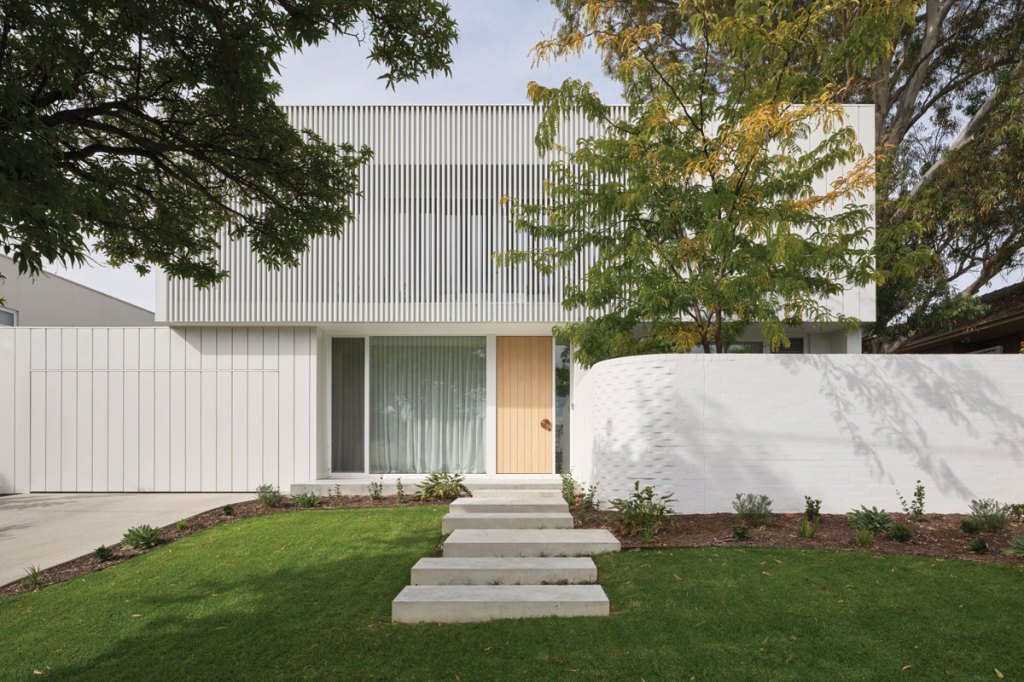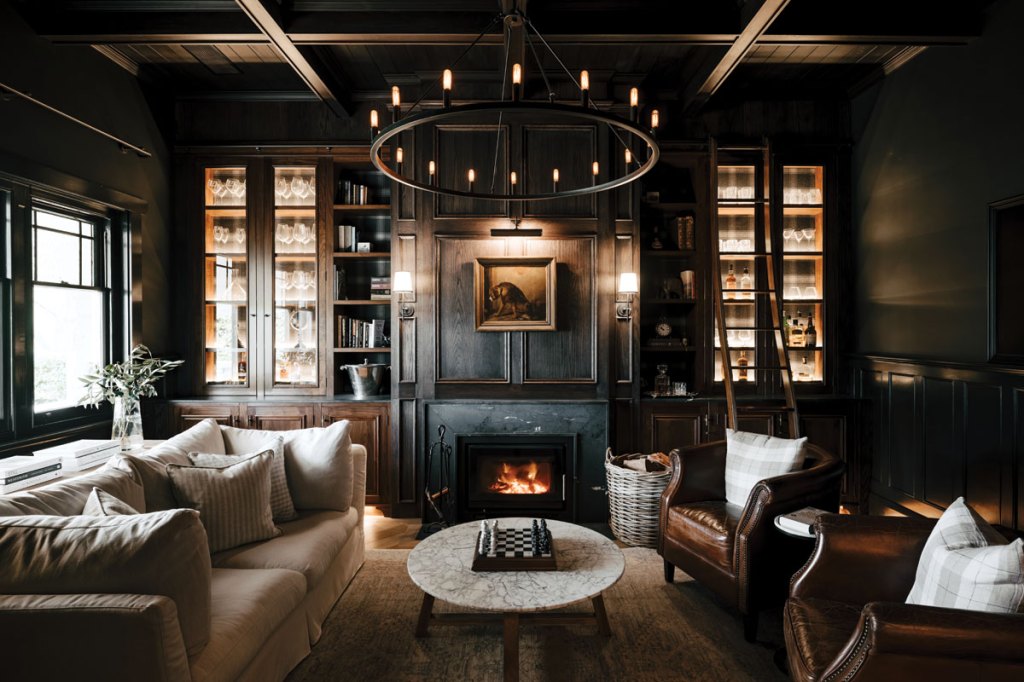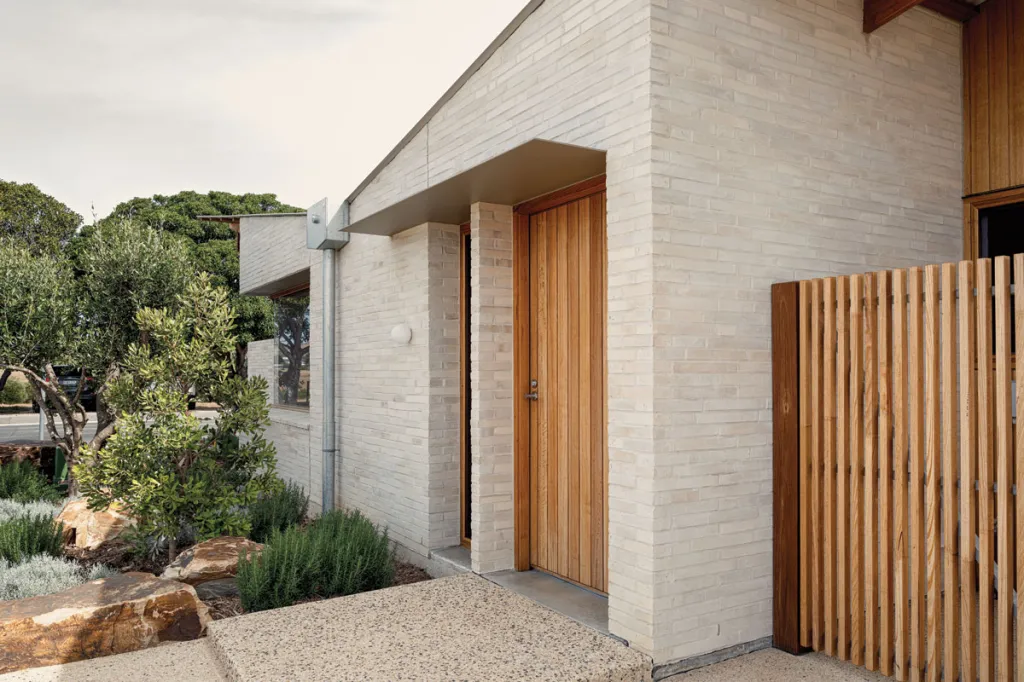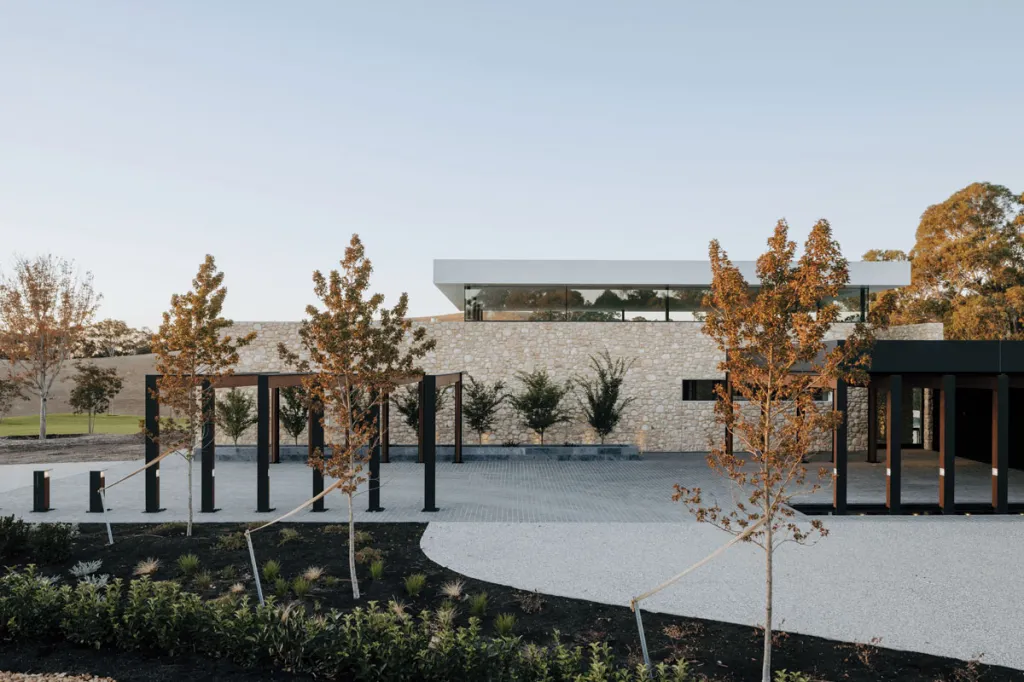The rich history of Anlaby Station
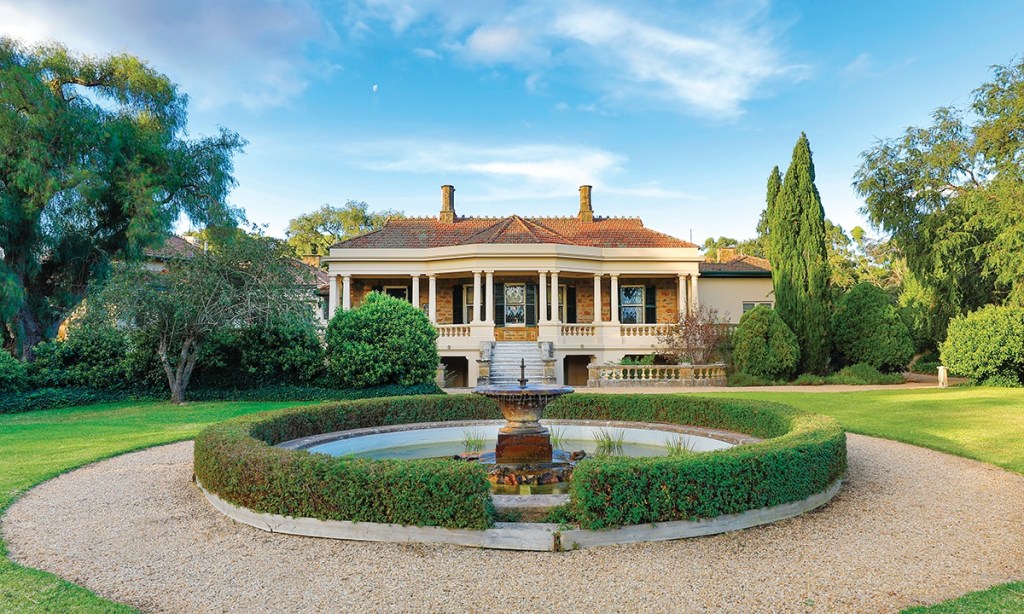
Here at Anlaby Station – nestled between the Barossa and Clare valleys – life has slowly returned to South Australia’s oldest merino stud.
Words Zoe Rice | Photographs Peter Hoare
As you drive up the long, gum-lined avenue that leads toward historic homestead Anlaby, it’s the galahs, magpies and wattle birds you notice first. They fly from one side of the path to the other, then dart back again.
It’s a game of hide-and-seek with the approaching cars as they flit between the thick trunks of the gums until, suddenly, they disperse when the sealed dirt road makes way for a stone path.
It was the unsealed, very dusty version of this dirt road that changed the lives of Sydneysiders Andrew Morphett and Peter Hayward when they first visited Anlaby – nestled between the Barossa and Clare valleys – some 20 years ago.

Anlaby owners Andrew Morphett and Peter Hayward in their library. Since moving in, they have worked on filling the built-in bookshelves that extend along three walls of the room.
When they first laid eyes on the grand old homestead, its cluster of nearby historic outbuildings and the overgrown surrounding garden, what was obvious was the astonishing wealth and vision of the colonial pioneers who established the property as a sheep station in 1839. What was also obvious was that the property had spent the better part of 50 years falling into disrepair.
Back in 2003, Andrew and Peter were searching for a perfect “weekender” to lure them away from the rush of Sydney’s financial district in which they both worked, and while it was unexpected they’d go as far as South Australia for that weekender, it was the beautiful, old bones of Anlaby that lured them across state-lines and headfirst into the history of this homestead, which reveals a new story of its past at every turn.
The first part of Anlaby’s story started back in 1839, when a group of colonial pioneers looking to capitalise on strong market prices in the new colony led a flock of sheep on a six-month trek from New South Wales to some 120 kilometres northeast
of Adelaide.

The less formal library features the Dutton family crest and motto, servabo fidem, I will keep the faith, beneath the mantle.
“In any other country, they would have made a film about
the journey,” Peter says. From the original flock of 18,000 sheep, some 5000 came from Frederick Dutton’s station in Goulburn. He decided to keep them on the land that is today known as Anlaby.
The irony doesn’t escape Andrew and Peter that 184 years later, it, too, was a long journey from Sydney that has breathed new life into the old merino stud.
“We were looking for somewhere as a weekender,” Andrew says. “The common-sense thing would have been to find something an hour or two from Sydney, or somewhere in Melbourne because we’re originally from Victoria.”

The drawing room’s fragile curtains are 120 years old with silk thread woven through them.
But after two years of failed attempts to find the perfect place, in 2002 they received a real estate brochure for Anlaby in the mail.
“We thought it looked really interesting and then when we got to the part that said ‘in South Australia’ we immediately thought: ‘That’s too far away, it’s not going to happen’.”
Nevertheless, there was something intriguing about the property, so they came to inspect it in early 2003.
You might like
“The first time we saw it, it was 38 degrees and Anlaby Road was gravel. We arrived in swathes of dust,” Andrew says.

The walls of the hallway that divides the old servants’ quarters from the rest of the home are covered in intricate-patterned wallpaper.
“It took five hours to do the inspection and as we drove away, we said, ‘That property’s definitely out; it’s far too much work’. Thirteen months later, we moved in.”
Before the couple purchased the property, they had
countless discussions about possible business models, because they knew straight away, if they purchased Anlaby they’d relinquish their dream for a relaxing weekend getaway and instead transform it back into a viable business, which would then help finance the restoration of the nine-bedroom, five-bathroom homestead.
That restoration started immediately. Peter says, thankfully none of the previous owners had “vandalised” the homestead with modern additions, but it had deteriorated significantly, with rain seeping into the house, even running down 100-year-old wallpaper in the drawing room.

The manor house is one of many outbuildings around the property and is used today as accommodation.
The first jobs were getting the roof water tight, rewiring, and fixing plumbing.
The home was void of furniture when Andrew and Peter moved in, so they brought across pieces from Sydney and purchased plenty from antique shops since.
They’ve also found pieces at auctions, garage sales and through friend and interior designer Malcolm Sheldrake of Riddell Marly in Melbourne.
Today, the house is resplendent in its grandeur – complete with a conservatory with a view to the formal garden, striking library and formal sitting room – but it’s the details that provide the real richness.

While the original furniture no longer remains at Anlaby, there are beautiful original design features, such as timber ceilings and colourful stained-glass windows.
And there are nods to the past everywhere: on the wall above Peter’s favourite chair in the tea room is a map of the district from the 1860s, Anlaby marked in red, then covering an astonishing 160,000 acres.
Then there’s the flower-arranging room, purpose-built to allow the lady of the house to practise floristry, given it was forbidden for her to go down to the scullery.
Upon entering the drawing room, there are explicit instructions: do not touch the curtains, they’re 120 years old.
If you have a keen eye, you’ll find dotted about the place the Dutton family crest and motto: servabo fidem, I will keep the faith, including under the mantle in the small library.

The grounds of Anlaby feature an extensive range of significant trees.
Soon after the restoration began, interested locals were calling, asking to do tours, which Andrew and Peter were initially hesitant to do.
“We were really embarrassed that people were paying money to turn up and look at what we thought was a rundown, desolate place, so we worked really hard to water and weed and get some of the garden beds going,” Andrew says.
That initial push from the public for Anlaby’s doors to open sparked the renewal that has brought the 1861 homestead and its stunning surrounds back in the public domain.
Once the jewel in Anlaby’s crown, the sprawling garden was the perfect example of the original owners’ penchant for displaying their passions. And money was no object for the Dutton family.

The formal gardens surrounding the main homestead have been planted English-style.
“They didn’t know the meaning of cannot; everything was possible,” Peter says. “They built a mushroom house and a cucumber house. Of all the things you could need in the universe – a cucumber house!
The outdoors really began to blossom when Fred’s nephew Henry Dutton inherited the property in 1890 after his uncle’s death and it featured everything from orchids gathered via boat from Far North Queensland to a concreted pool of ocean water in an attempt to lure seagulls (Henry fancied the birds). This was one of the rare failures among the ideas.
Much of that Edwardian garden infrastructure still stands today, including the terracing, cucumber house, camelia house, mushroom house, shade house and water feature.
Subscribe for updates

The garden’s infrastructure was luxurious in its day and included a cucumber house, a mushroom house and this apple house.
“It’s probably the most-complete Edwardian garden of its size in South Australia and it’s really a very significant part of the state’s history,” Peter says.
As was common when the garden was established, it is divided into “rooms” and begins with a formal garden with hedging and lawn surrounding the water fountain.
Moving further afield, there’s a fruit orchard, rockery, veggie garden, flower beds, significant trees, a pond, tennis courts and all the various houses for the indoor-growing plants.
While in its heyday, a team of 14 gardeners tended to it, today it’s Darin Gladigau who oversees the 10 acres of green space.

Anlaby’s gardener Darin Gladigau in his favourite spot, the rockery.
Walking into a garden of this size and importance can be a daunting task, but Darin says the first order of business is simply keeping things alive that are already established and then getting into routines.
For a non-native garden, the introduced plants have miraculously survived decades without the attention they would have been used to in the late 1890s.
“We have species of tulips that we definitely didn’t plant but have just come up,” Peter says.
“They’ve been probably sleeping and coming up and no one was seeing them.”
Perhaps one of the most special surviving plants is a Souvenir de la Malmaison rose, believed to have been gifted to the Dutton family by famed painter Nora Heysen (a letter has been found that references the plant) and it now takes pride of place under a rebuilt pergola.

The old path that horse and cart would have traversed in the early days of Anlaby.
Darin explains: “The original pergola had fallen down and this single Souvenir de la Malmaison rose was surviving underneath all of the overgrown garden, so we rebuilt the pergola and reinstated the roses all along it.”
Just a short trip from the edge of the garden, beauty makes way for more practical pursuits with the farm, which runs 1700 sheep, producing about 10 tonnes of wool each year.
When Andrew and Peter first moved in, they had 150 acres to contend with, but in 2007, they bought back the original farm as well as the sheep that had been sold to a neighbour.
Today, the property is just shy of 2000 acres and Peter says to have sheep back on the land brings with it a sense of everything being right again at Anlaby.
“When the truck arrived and the sheep came off the back of it, we thought, Anlaby’s got sheep again, it’s complete. It makes sense again,” Peter says.

Farm manager Liam Sander is new to the job and he and his team run 1700 sheep, including a heritage flock comprising sheep from the original bloodline, which produce about 10 tonnes of wool each year.
“It was one of those watershed moments. People say when the ravens leave the Tower of London, there will be chaos and it felt the same with the sheep.”
Among the sheep, is a heritage flock comprising sheep from the original bloodline that made their way from New South Wales all those years ago. Their wool, processed in Scotland, is used in a range of luxury products.
Then there are the outbuildings, including the sizeable slaughterhouse, shearing shed, the manor house, coachman’s cottage and gardener’s cottage as well as stone remnants of other buildings. They are dotted around the property, and their states range in anything from beautiful and functional to utter ruins. Some have been restored and are now bed and breakfast accommodation.
In the glory days of the Dutton family, these buildings constituted Anlaby’s own little village of up to 70 people. Today, Anlaby employs a tight-knit team, including Darin, tour guide Sam Doering, farm manager Liam Sander and guest services manager Bianca Saegenschnitter.

In autumn, the vines on the manor house turn a brilliant, blazing orange.
As Peter and Andrew relax in the tea rooms looking out to the maypole garden, they reflect on the importance of the property’s legacy, which goes beyond sheep farming.
As one legacy goes: Frederick Dutton’s brother, Francis, was out chasing sheep in a storm in 1842 when he found a bit of green rock. He took it to his neighbour, Charles Bagot, whose son had found a similarly hued rock. The pair quietly staked out a mining lease and the country’s first copper mine was founded.
It’s the stories like this that mean Andrew and Peter don’t regret for a moment their decision to forgo the purchase of a quiet “weekender”.
“You sort of buy into the story and that’s why you persist,” Peter says. “The place gets under your skin a bit.”
The couple doesn’t have children, so their reinvigoration of Anlaby is about putting it in good stead and making it appealing to future generations, creating a compelling reason for the next custodians to care for it in the same way.
Andrew sums it up: “This is about what’s right for the property and the community and the broader state.”
This article first appeared in the May 2023 issue of SALIFE magazine.
